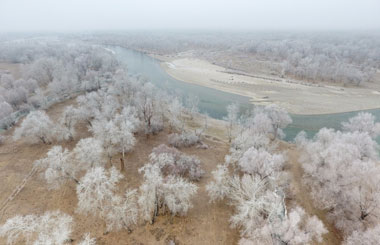A province that marches with the times
Hebei province has been playing an important strategic and cultural role in China for more than 2,000 years.
True, its proximity to Beijing enhances its geographical and strategic importance. But Hebei enjoyed that advantage even before Beijing became China's political capital, because it connected the rest of the country with the regions inhabited by the Manchu ethnic group in the north and by Mongols in the west, and the sea in the east. Not for nothing has it been part of many historical changes in China since the Warring States (475-221 BC) period.
The province is also known for the Great Wall, which starts in the costal city of Shanhaiguan, a time-honored seaside mountain pass to Northeast China. A span of about 2,000 kilometers of the Great Wall dots the countryside of Hebei and has been preserved by the provincial government. Another of its coastal cities, Qinhuangdao, was developed as the largest coal port in 1898, and remains an important city today.
To the west of Hebei is the Taihang Mountain range, which was an important base for the Chinese army fighting the Japanese invaders during World War II. Those bases today are major tourist attractions, generating jobs and incomes for many people.
Thanks to Hebei's long history and rich cultural heritage a lot of folk arts and handicrafts, including shadow puppets, paper cuts, folk acrobatics and other performing arts, are well preserved in the province even today.
But these are different times, the times of economic development and constantly rising GDP growth. Not surprisingly, Hebei has kept pace with the changing times. Of course, the province enjoys certain advantages. Since geographically Hebei almost encircles Beijing and Tianjin, a wide span of its area has become an important part of the Bohai Bay Economic Rim.
Tangshan stands as a shining example of Hebei's resilience and determination to overcome odds. The now famous portal and industrial city of Tangshan was devastated by an earthquake, which killed more than 242,000 people, in 1976. The city has risen from its ashes to become an important center of chemicals, coal mining, logistics and ceramics.
But again, it is Hebei's closeness to Beijing (and Tianjin) that makes it special today. The success of the Bohai Bay Economic Rim depends as much on Beijing, Tianjin and parts of Liaoning and Shandong provinces as it does on Hebei - and this is a role that Hebei is well cut out to play.
Traditionally, the strong point of the Bohai Bay Economic Rim has been heavy industries and manufacturing. Tianjin has for long been an important aviation, logistics and shipping center. Beijing is now a strong petrochemical, education, and research and development hub. Shenyang, capital of Liaoning province, is known for its auto, software and aircraft sectors. Dalian, a major port city of Liaoning, attracts many foreign investors. Qingdao, Shandong province, is another major seaport and big industrial city.
Hebei's strength, apart from its other advantages, lies in that it links all these cities and regions together in the Bohai Bay Economic Rim. The province has been building an advanced communications network, better highways and allocating more funds to the education sector to better use the resources in the economic rim and act as a modern infrastructural link.
Hebei also has plans to cater to the demands of new cultural industries by building theme parks, information technology parks, computer animation centers and bases for performing arts.
Moreover, Hebei provides Beijing and Tianjin the cushion for expansion of their heavy industries and access to seaports and natural resources. In fact, Caofeidian, 70 km south of Tangshan, is being built as a new port for Beijing Capital Iron and Steel Group, one of the largest of its kind in China.
Given the increasing importance of the Bohai Bay Economic Rim, Hebei is well set to continue playing an important role even in modern China's economic development.
The author is director of publicity department and a member of the standing committee of CPC Hebei provincial committee.














